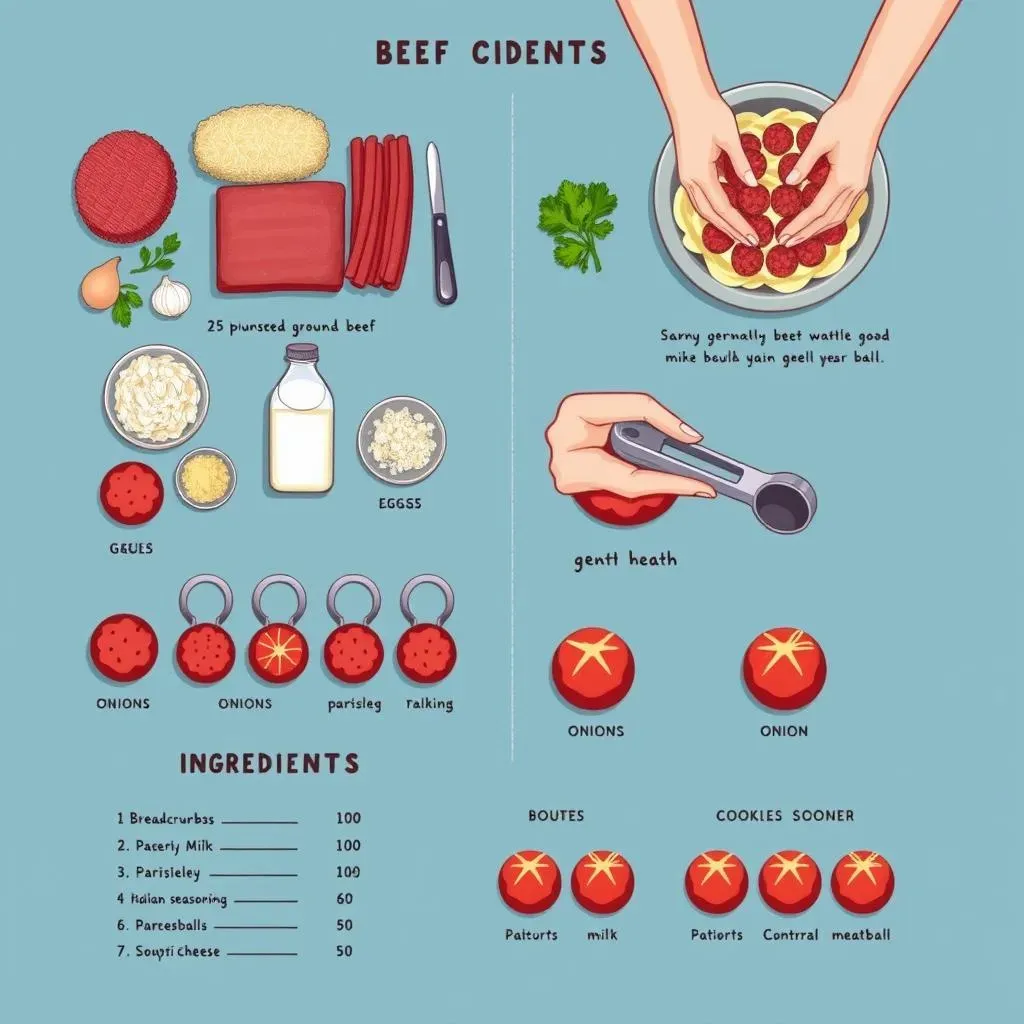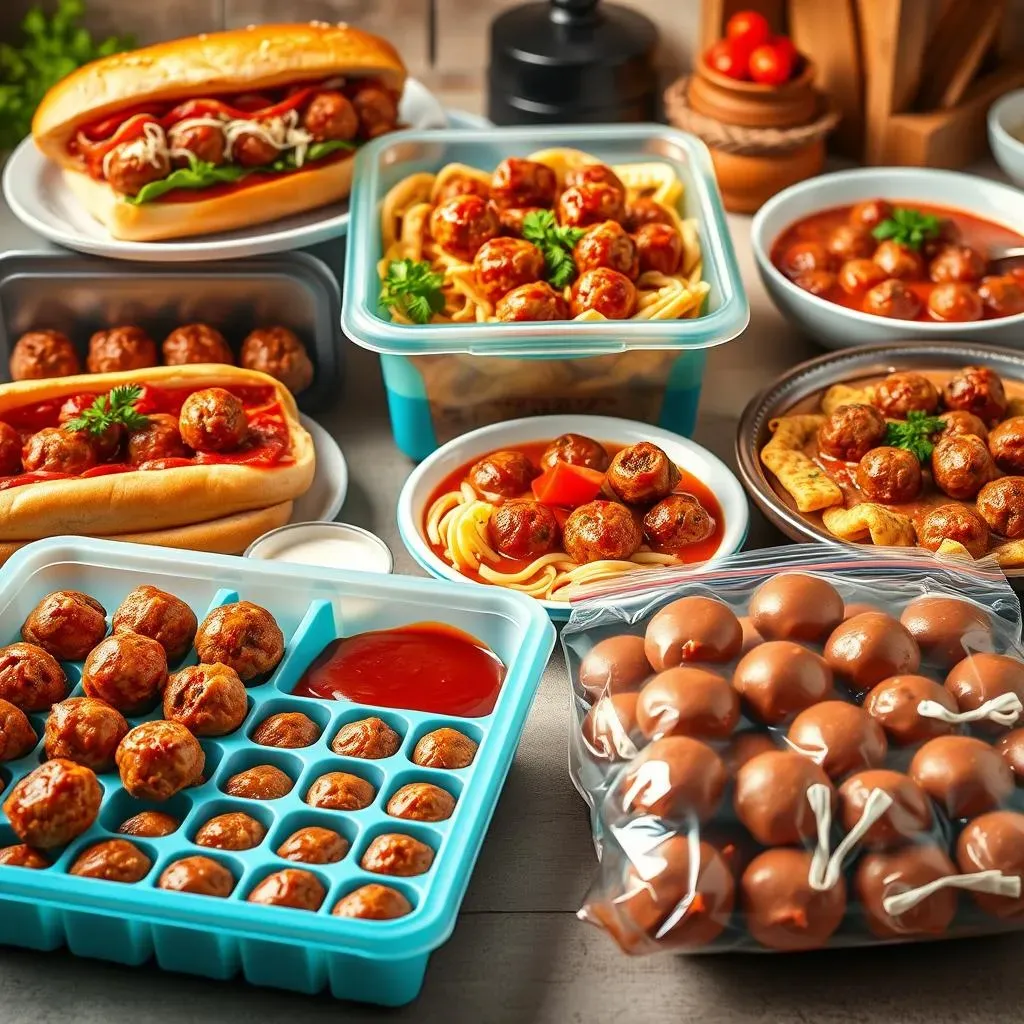Table of Contents
Planning a party, feeding a crowd, or simply craving a mountain of delicious meatballs? Then you've come to the right place! This comprehensive guide tackles the seemingly daunting task of creating a whopping 100 beef meatballs. Forget generic recipes; we're diving deep into the art of crafting perfectly juicy, flavorful meatballs – 100 of them! We’ll walk you through a detailed, easy-to-follow 100 beef meatballs recipe, sharing expert tips and tricks to ensure each meatball is a tiny masterpiece. Don't worry about scaling up – we'll equip you with the knowledge to efficiently handle this ambitious project. From preparation and cooking techniques to creative serving ideas and smart storage solutions, this article covers everything you need to know. Get ready to impress your guests (or yourself!) with this ultimate guide to the 100 beef meatballs recipe. Let’s get cooking!
Mastering the 100 Beef Meatballs Recipe: A StepbyStep Guide

Mastering the 100 Beef Meatballs Recipe: A StepbyStep Guide
Ingredient Gathering and Prep
First things first: We need a serious shopping list! For 100 meatballs, you're looking at a significant amount of ground beef – we recommend at least 25 pounds of high-quality 80/20 blend for optimal juiciness. This ensures each meatball is tender and flavorful. Don't forget the supporting cast: breadcrumbs (about 4 cups), eggs (a dozen or more, depending on the size), milk (at least 2 cups), and a whole lot of aromatics! Think: 3-4 large onions, several cloves of garlic, fresh parsley (a generous bunch), and your favorite Italian seasoning blend. Consider adding some grated Parmesan cheese for extra richness. Remember, we’re aiming for flavor in every bite!
Before you start mixing, prep your ingredients. Finely grate the onions; this helps them distribute evenly throughout the meatball mixture, resulting in a more consistent flavor. Mince the garlic and chop the parsley. Having everything ready to go will make the mixing process much smoother, and it will be more efficient. Trust me, you'll thank yourself later when you're not frantically chopping onions while juggling pounds of ground beef!
- Ground Beef (25+ lbs)
- Breadcrumbs (4 cups)
- Eggs (12+)
- Milk (2+ cups)
- Onions (3-4 large)
- Garlic (several cloves)
- Parsley (generous bunch)
- Italian Seasoning
- Parmesan Cheese (optional)
The Mixing Process: Gentle is Key
Now for the fun part – mixing! This is where many home cooks go wrong. Overmixing leads to tough meatballs. Instead, gently combine the breadcrumbs, eggs, milk, and seasonings in a large bowl. Once everything is evenly moistened, gradually add the ground beef. Use your hands (or a very light touch with a large spoon) to incorporate the meat, being careful not to overwork it. The goal is to combine the ingredients, not to create a dense, overworked mixture. Think of it like making a delicate cake batter – gentle and steady wins the race. For a truly even distribution of flavors, many cooks swear by the technique of grating the onions and garlic rather than chopping, but you can do as you please.
Once everything is nicely combined, it's time to form the meatballs. For consistency and efficiency, use a cookie scoop or a large spoon to portion the mixture into uniform-sized balls. This ensures even cooking and beautiful presentation. If you are making a smaller batch of meatballs, you can easily adjust the recipe by reducing the amounts of ingredients proportionately. For example, if you only need to make 20 meatballs, simply divide all the ingredient quantities by 5. Check out our 2 lb meatball recipe for a smaller-scale guide.
Ingredient | Amount (for 100 meatballs) | Amount (for 20 meatballs) |
|---|---|---|
Ground Beef | 25+ lbs | 5 lbs |
Breadcrumbs | 4 cups | 4/5 cup |
Eggs | 12+ | 2-3 |
Scaling Up: Tips and Tricks for Making 100 Perfect Beef Meatballs

Scaling Up: Tips and Tricks for Making 100 Perfect Beef Meatballs
So, you're ready to tackle 100 meatballs? Awesome! But scaling up isn't just about multiplying ingredients. It's about optimizing your process for efficiency and consistency. Think of it like an assembly line for deliciousness. First, consider your equipment. A couple of large bowls won't cut it; you'll need several large mixing bowls, ideally stainless steel for easy cleanup. A stand mixer with a dough hook might seem like overkill, but for this scale, it could be a lifesaver, saving you serious arm fatigue. And don't forget multiple baking sheets! You'll likely need to bake these in batches. Prep those ahead of time!
To maintain consistency, consider using a kitchen scale to weigh out your ground beef. It's far more accurate than eyeballing 25 pounds of meat! This ensures each meatball gets roughly the same amount of meat, leading to even cooking and consistent size. For a smaller batch, check out our 2 lb meatball recipe for a more manageable approach. Remember, precision is your friend when you're dealing with this volume.
- Multiple large mixing bowls
- Stand mixer (optional, but recommended)
- Kitchen scale
- Multiple baking sheets
- Cookie scoop or large spoon
Batch cooking is your best friend here. Don't try to bake all 100 meatballs at once; your oven simply won't handle it. Instead, divide the mixture into smaller, manageable batches. This ensures even cooking and prevents some meatballs from drying out while others remain undercooked. You might even consider using two ovens if you have them! Remember to rotate the baking sheets between the oven racks to ensure even browning. This step is crucial for producing uniformly cooked and delicious meatballs.
Finally, don't forget the importance of chilling. Once your meatballs are formed, chilling them in the refrigerator for at least 30 minutes before baking helps them firm up. This prevents them from falling apart during cooking and results in a better texture. For a truly professional touch, you can even flash-freeze them on a baking sheet before storing them in the freezer. This prevents them from sticking together, making it easy to grab a handful for a quick meal later. Check out our freezing beef meatballs guide for more information.
Batch Size | Approximate Baking Time (375°F) | Notes |
|---|---|---|
20-25 meatballs | 25-30 minutes | Rotate halfway through |
30-35 meatballs | 30-35 minutes | May require two baking sheets |
Serving and Storing Your 100 Beef Meatballs: Delicious Ideas and Storage Solutions

Serving and Storing Your 100 Beef Meatballs: Delicious Ideas and Storage Solutions
Serving Suggestions: Beyond Spaghetti and Meatballs
Let's face it: spaghetti and meatballs is a classic for a reason. But with 100 meatballs at your disposal, you have a world of culinary possibilities! Think beyond the usual suspects. How about a hearty meatball sub? These are perfect for a casual get-together. Or perhaps a vibrant meatball pizza? The possibilities are endless. You could even use them as a base for a delicious meatball stroganoff. For a truly unique twist, try a flavorful meatball soup, a comforting bowl of goodness perfect for a chilly evening. Don't forget smaller appetizers – individual meatballs with a dipping sauce are always a crowd-pleaser!
Consider themed buffets. An Italian feast comes naturally to mind, but you can also explore other cuisines. Imagine a Mediterranean spread featuring your meatballs alongside hummus, pita bread, and olives. Or go global with a fusion buffet—think Asian-inspired meatballs with a sweet chili glaze alongside rice and stir-fried vegetables. The key is to get creative and explore different flavor profiles to showcase the versatility of your meatballs. For more inspiration, check out our beef meatball spaghetti recipe for a classic approach.
- Meatball Subs
- Meatball Pizza
- Meatball Stroganoff
- Meatball Soup
- Appetizer Meatballs with Dipping Sauces
Smart Storage: Freezing for Future Feasts
With 100 meatballs, you're likely to have leftovers (or maybe you're planning ahead!). Proper storage is crucial to maintaining quality and preventing freezer burn. The best method is flash-freezing: Arrange the cooked meatballs in a single layer on a baking sheet lined with parchment paper. Freeze them until solid (about 30 minutes to an hour), then transfer them to a freezer-safe bag or container. This prevents them from sticking together. Label the bag with the date for easy tracking, and remember that frozen meatballs generally last for 2-3 months for optimal quality. Check out our freezing beef meatballs guide for additional tips and tricks.
For shorter-term storage (up to a week), you can store cooked meatballs in an airtight container in the refrigerator. Make sure they're completely cooled before refrigerating to prevent moisture buildup and bacterial growth. When reheating, avoid overcooking; gently warm them in a saucepan with a little sauce, or in the microwave. Reheated meatballs are great in pasta dishes, sandwiches, or as a quick addition to soups and stews. Remember, proper storage ensures that your delicious meatballs remain enjoyable for days or even months to come. For more ideas on using your leftover meatballs, take a look at our beef meatball soup recipe.
Storage Method | Storage Time | Reheating Method |
|---|---|---|
Freezer (flash-frozen) | 2-3 months | Oven, microwave, or saucepan |
Refrigerator (airtight container) | Up to 1 week | Microwave or saucepan |
Beyond the Basics: Creative Meatball Storage
While freezer bags and containers are reliable, let's explore some more creative storage options. For individual portions, consider using ice cube trays. Place a single meatball in each cube, freeze until solid, and then transfer to a freezer bag. This makes grabbing a single serving incredibly easy. For longer-term storage, vacuum-sealing is a great option. Vacuum-sealed bags remove air, minimizing freezer burn and extending shelf life. This method also helps maintain the moisture and flavor of the meatballs.
Remember, proper preparation is key. Before freezing, ensure your meatballs are completely cooled. This prevents condensation and ice crystal formation, which can compromise the texture and flavor. For even more advanced storage techniques, consider investing in a food dehydrator to make incredibly long-lasting meatball jerky. If you have a very large freezer and are making a very large batch of meatballs, you can also consider freezing them in portions on baking sheets, then transferring them to large freezer bags. This method is great for preserving the quality of your meatballs over a longer period.
- Ice cube trays for individual portions
- Vacuum-sealing for extended shelf life
- Food dehydrator for making meatball jerky
- Freezing in portions on baking sheets